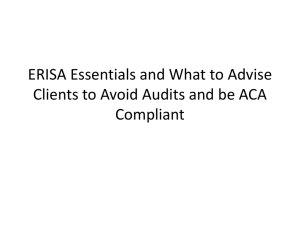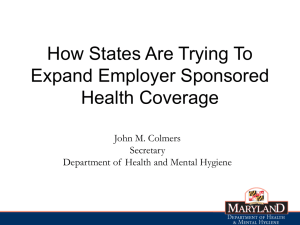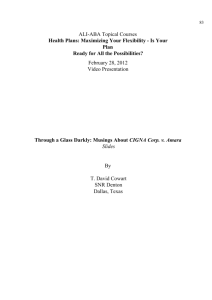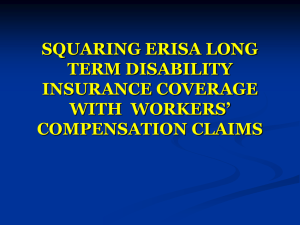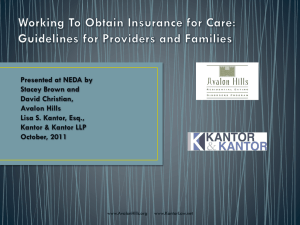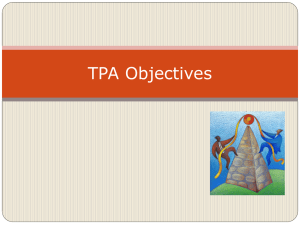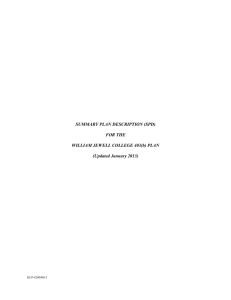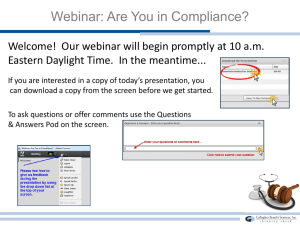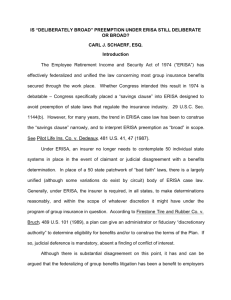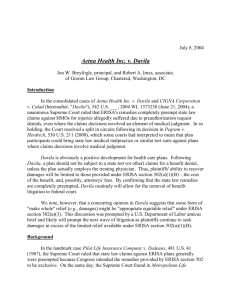File
advertisement
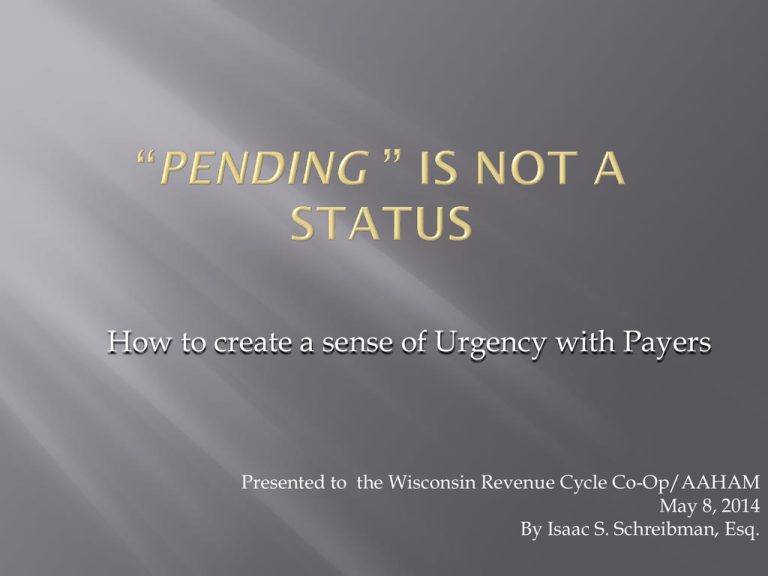
How to create a sense of Urgency with Payers Presented to the Wisconsin Revenue Cycle Co-Op/AAHAM May 8, 2014 By Isaac S. Schreibman, Esq. Delayed payment reduces the value of claims Appreciate the importance of maintaining communication with the patient throughout the follow up process Insure2 that claims and appeals are received in a timely manner Identify and understand issues preventing prompt payment and overcoming obstacles to prompt payment 2 Understand the process Understand timeframes System knowledge Patient contact Detail driven Utilize available rights and remedies Identify “pressure points” Clearly explain expectations 3 Third Party Administrator Adjuster Repricer Payer Payment Review PPO “Silent” PPO 4 PLAN ADMINISTRATOR (EMPLOYER) Self-funded or group (commercial ) carrier Legally Responsible to pay valid claims Statutory (ERISA) and contractual Liability Authority to override decision of TPA BENEFIT ADMINISTRATOR (TPA) Review and approve claims for payment Engage “re-pricers” Process payment and issue Explanation of Benefits Attempt to access PPO networks (silent PPO) 5 “Silent PPOs” Identify re-pricers (can work for TPA) Detailed examination of the EOB Validate written agreements are in place Review Summary Plan Description Keep focus on the entity contractually responsible for payment (e.g. health plan, employer) 6 7 Found on-line, not in policy Defines covered procedures as medically necessary only when specific conditions are met Detailed, lengthy and very complex Defines what treatments and procedures have to be attempted before procedure in question will be approved as medically necessary 8 UB 04 HCFA 1500 Summary Plan Description Explanation of Benefits Assignment of Benefits Remittance/Denial 9 An appropriate worded and properly executed Assignment of Benefits/Authorization to Represent is a powerful tool to be used when attempting to obtain meaningful status of claims and to resolve claims requiring additional information . Many times the insurance representative will initially refuse to provide more detailed information than “claim pending” or “claim under investigation” claiming confidentiality concerns. If there is a valid Assignment of Benefits in the file the provider’s representative should advise… 10 The hospital is the Assignee of the patient’s insurance benefits and as such stands in the shoes of the patient and has all the rights and interests that the patient has regarding his insurance policy/claim. Let me fax a copy of the Assignment of Benefits to you. By executing that document the patient has given the Hospital the right to obtain information and documentation regarding their pending claim and to take any action necessary to enforce their claim. 11 ASSIGNMENT OF BENEFITS / ERISA AUTHORIZED REPRESENTATIVE FORM The Hospital Assignment of Insurance Benefits I hereby assign my rights, title and interests in all applicable health insurance benefits to which I am entitled to (the Hospital). I certify that the health insurance information that I provided to the Hospital is accurate as of the date set forth below and that I am responsible for keeping it updated. I hereby authorize Provider to submit claims and appeal denied claims, on my behalf, to the benefit plan (or its administrator) as I provided to the Hospital, in good faith. I hereby authorize my benefit plan (or its administrator) to pay the Hospital directly for services rendered to me. If my current policy prohibits direct payment to Provider, I hereby instruct and direct my benefit plan (or its administrator) to provide documentation stating such non-assignment to myself and the Hospital upon request. Upon proof of such non-assignment, I instruct my benefit plan (or its administrator) to make out the check to me and mail it directly to Provider. Authorization to Release Information I hereby authorize the Hospital and my benefit plan to: (1) release any information necessary to my health benefit plan (or its administrator) regarding my illness and treatments; (2) process insurance claims generated in the course of examination or treatment; and (3) allow a photocopy of my signature to be used to process insurance claims. This order will remain in effect until revoked by me in writing. ERISA Authorization I hereby designate, authorize, and convey to The Hospital to the full extent permissible under law and under any applicable insurance policy and/or employee health care benefit plan: (1) the right and ability to act as my Authorized Representative in connection with any claim, right, or cause in action that I may have under such insurance policy and/or benefit plan; and (2) the right and ability to act as my Authorized Representative to pursue such claim, right, or cause of action in connection with said insurance policy and/or benefit plan (including but not limited to, the right and ability to act as my Authorized Representative with respect to a benefit plan governed by the provisions of ERISA as provided in 29 C.F.R. §2560.5031(b)(4) with respect to any healthcare expense incurred as a result of the services I received from the Hospital and, to the extent permissible under the law, to claim on my behalf, such benefits, claims, or reimbursement, and any other applicable remedy, including fines, interest and attorney’s fees. A photocopy of this Assignment/Authorization shall be as effective and valid as the original. Patient Date Policyholder/Insured Date 12 To obtain a copy of the Summary Plan Description (Policy Specifications) To obtain a comprehensive listing of all policy exclusions, restrictions and limitations To request that the insurer provide specific details concerning what steps they have taken to obtain required information/documentation, To obtain copies of correspondence and documentation sent to the insured To obtain copies of all legal notices sent to the insured or policy beneficiary To obtain reports, records and other documents prepared in connection with the insurer’s review of a submitted claim To exercise certain rights where the insured is deceased 13 Date of Accident/Injury Type of injury Location Parties involved Insurance coverage Policy limits Adjuster assigned Adjuster contact information Claim number Date claim opened Claim status 14 Identify the entity to whom you are speaking What stage of the process is the claim in? What information or action is required to complete the process? Who is responsible for the next action step? When will the next action be taken on the claim? “PENDING” IS NOT A STATUS ! 15 Obtain collateral information Clearly identify disputed issues (coverage, treatment) Confirm outstanding issues in writing (large balance accounts) Does the Patient have legal representation? If so obtain attorney contact information Request that the insurance representative confirm current, detailed status in writing 16 Medical Records Required Information Required from Patients (COB info) Patient Statements/Medical Exams required (have they been scheduled, when) Accident Reports (Liability/No-fault Claims) Coverage/Liability Determinations What can you do to assist with the process-especially patient contact!! 17 Be wary of multiple (and inconsistent) denial reasons (e.g. not covered and charges not reasonable and customary) Identify documentation and information required to overcome the denial (letter from treating physician) Was the treating physician paid by the same carrier for the same service? 18 Why should it take 90 days to pay a claim? Who am I speaking with; insurance carrier, Third Party Administrator, Re-pricer? Is the patient aware of the current status of their claim? When was the last contact with the patient? Keep the patient informed and involved Do you have copies of all correspondence sent by the insurance company to the patient? 19 Policy limits Accident Reports Results of Independent Medical Exams Denial Letters Requests for additional information Copies of legal pleadings 20 Faxes and Letters as alternatives to leaving messages Letter of Representation/Authorization Detailed questionnaire to patient Request for information to attorney and adjuster Request for written status from insurance company 21 Use of certified mail Clear and concise cover letters for appeals Should be addressed to a specific person Use of supporting letters (treating physicians) Elaborate on medical records 22 Confirm receipt of all correspondence within 72 hours Suggest that claim be “escalated” (because of age, balance or disputed issue) Clearly document a valid status, progress of claim review and anticipated next step 23 Secure patient cooperation Become the patient’s advocate, not adversary Confirm patient contact information (e-mail and alternate telephone numbers) Obtain special authorization to represent the patient Keep the patient in the loop Have the patient contact their benefit coordinator 24 ERISA Plans Employee Retirement Income Security Act of 1974 (ERISA) (Pub.L. 93–406 Self-funded Group Carriers Employers can override the decisions of their group carriers 25 ERISA was enacted to protect the interests of employee benefit plan participants and their beneficiaries by: • • • Requiring the disclosure of financial and other information concerning the plan to beneficiaries; Establishing standards of conduct for plan fiduciaries; Providing for appropriate remedies and access to the federal courts. 26 Keep them involved in the process (advise them of adverse decisions of TPA or Group Carrier) Employers can override decisions of TPA or Group Carrier Engage patient and employer, throughout the entire process Workers Compensation Cases (payment of outstanding medical bills) Workers Compensation Denials 27 Patient represented by an Attorney Legal proceeding pending No payment or final disposition within 120 days from bill date Conflict between multiple carriers Unsupported denials Additional information needed from patient 28 Increase effectiveness in dealing with patients’ attorneys and insurance companies Understand and resolve complex reimbursement issues Increase level of intensity on high balance accounts Sense of “urgency” Legal Action 29 Internal appeals External independent appeals State administrative remedies (Department of Insurance) Prompt payment interest Federal Court (ERISA) 30 Denial or payment of claims within 30 (calendar) days of submission of claim (§628.46) Written notice of covered loss and amount of claim required Interest of 1% per month Office of the Commissioner of Insurance (608)-266-3585 http://oci.wi.gov/ocihome.htm 31 Questions and Discussion 32 33 Out of plan payer was billed for services provided to the patient in the amount of approximately $120,000 Hospital billed TPA and TPA engaged a repricer Repricer paid the Hospital $27,000, 10 months after billing, claiming balance of charges were not “reasonable and customary” Payer was a self-funded ERISA plan 34 Hospital’s attorney demanded a copy of the employer’s Summary Plan Description. The Plan provided for payment of 100% of charges after patient met deductible and co-pay. Using the Assignment of Benefits signed by the patient the Hospital filed a lawsuit against the employer in federal court based on the provisions of ERISA The pending action seeks $88,000 in charges plus interest and attorney’s fees 35 Patient had relatively new procedure performed. Procedure was cheaper, faster and less intrusive. Procedure was peer recognized and supported. Internal appeals upheld the original denial and were exhausted. Requested and received an independent external appeal –(PPACA) 36 Submitted detailed appeal with the following appendix of supporting documents; Authorization to Represent and Request for External Independent Review-executed by Patient Level II Appeal dated 8/6/2012 Operative and Discharge Reports Bill submitted to Cigna for the procedure under appeal Letter from treating surgeon Explanation of Benefits for 4/2011 treatment Letter from CIGNA dated 9/28/2012 Bibliography of clinical articles related to Transoral Incisionless Fundoplication (TIF) procedure TIF Clinical Results –EndoGastric Solutions FDA Approval of Device (21 CFR § 876.1500) Statement from the American Society of General Surgeons dated 4/1/2011 Letter from the Patient Copies of specific articles cited in appeal letter and letter from treating surgeon 37 Original denial was upheld by Independent external review Appealed to employer to override decision Employer agreed and directed that claim be paid 38 For copies of referenced material; Ike Schreibman The Law Office of Isaac Schreibman ike@ikeschreibmanlaw.com (847) 756-7606 (O) (847) 970-8248 (C) 39
